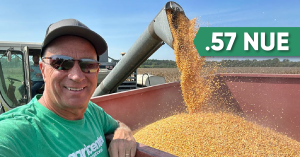This Week In Ag #111
It’s Easter week. In addition to the religious celebration, that means eggs. Lots of them. Americans purchase 180 million eggs just for Easter.
Eggs are the ultimate symbol of new life, which aligns perfectly with the celebration of Easter. The practice of gifting eggs dates back to the early days of the Church when Christians fasted during Lent. Since this was well before refrigeration, meat wasn’t processed during Lent since it wasn’t easily preserved. But eggs could be.
Unwashed eggs – gathered fresh from under the hen – feature a natural coating called the bloom. This layer protects harmful bacteria from entering the shells, allowing eggs to be stored at room temperature for weeks. So people saved their eggs and gave them to children on Easter. They would also paint them, often with the color red to signify the blood of Christ.
Over time, people began to hard boil and decorate these eggs. And now, of course, we have those chocolate eggs that many of you will be hiding Saturday night. Over 91 billion chocolate eggs are sold for Easter.
Another egg tradition is the Easter egg roll, symbolizing the stone rolling from Christs’ grave. The most famous egg roll is held annually at the White House. This tradition dates back to the time of Abraham Lincoln. These egg-rolling parties quickly grew in popularity, so much so that Ulysses S. Grant banned them citing concerns over damaging the landscape (maybe taking away egg parties led to his universal ranking as one of the worst US Presidents?). Fun was restored under Rutherford B. Hayes.
In 1878, a group of children approached the White House gate, asking to play egg games. President Hayes obliged, and the official White House Egg Roll was hatched, so to speak. The custom blossomed, with President Benjamin Hayes calling on the US Marine Band to add music to the event in 1889. There were a few stoppages during the world wars and during White House construction. President Dwight Eisenhower brought back the event in 1953.
In the modern era, planning for the event has fallen on First Ladies. Mrs. Hoover incorporated folk dancing, while Mrs. Nixon introduced the races we still see today. Mrs. Reagan instituted a commemorative wooden egg keepsake, autographed by the President and First Lady. To manage the demand for egg rollers on Easter Monday, a lottery system has been instituted for lucky children across all US states and territories.
Related Posts

Use of Biostimulants for Upset Recovery in Paper Mill Wastewater Systems
By Heather Jennings, PE Two specific Probiotic Solutions® liquid bioremediation products were used at a large-scale paper mill in China to address system upsets caused by hydraulic loading from new upstream processes. The products involved are Bio Energizer® (BE)—a scientific formulation of organic acids, buffers, natural biological stimulants, micronutrients, and energy systems—and Micatrol® (MT), a

This Week in Ag #47
Nitrogen Use Efficiency has quickly become part of the vocabulary surrounding sustainability. But NUE is more than just a buzzword or another fancy acronym. NUE is the benchmark for nitrogen management. You’ll often see it used to measure the amount of nitrogen used to produce a bushel of grain. NUE is a pillar for calculating

Q&A: Leveraging Biostimulants and Biofertilizers for Sustainable Growth
Fred Nichols, Chief Sales and Marketing Officer at Huma®, shared his perspective in a recent article on biostimulants and biofertilizers, published in CropLife and American Fruit Grower Magazine. In the article, Fred discusses the growing role of these products in sustainable agriculture, their benefits, and their impact on crop production. Below are the questions posed

